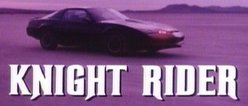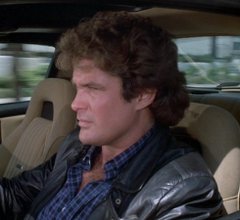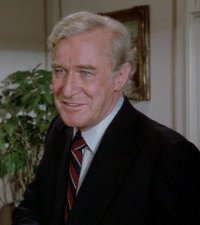Knight Rider
Knight Rider was a popular United States television show during the early 1980s. It was broadcast on the NBC television network and starred David Hasselhoff as Michael Knight; a kind of modern-day 'knight' who drove an advanced smart car with artificial intelligence. more...
Conceived and produced by Glen A. Larson, the show was an instant hit and inspired a subgenre of high-tech crimefighter series.
Story
Michael Knight
In the pilot episode, undercover police officer Michael Long was betrayed and seemingly killed by a gunshot wound to the head. In reality, a metal plate in Long's skull deflected the round which shattered and damaged his face. Declared dead to the public, his medical care was actually taken over by the Foundation for Law and Government (FLAG).
FLAG is a private crime-fighting arm of the Knight Foundation, founded by dying millionaire philanthropist Wilton Knight. Given a new face via plastic surgery, Michael Long was resurrected as Michael Knight. Together with a high-tech automobile called KITT (Knight Industries Two Thousand), Michael set out to carry out Wilton Knight's crime-fighting crusade. He was usually given mission objectives by the new director of FLAG, Wilton's friend Devon Miles. Michael was selected for his high level of training in both deduction and self defense.
Michael Knight is a new kind of hero, a modern knight, who avoided unnecessary violence and refrained from using firearms. Most episodes featured an attractive young woman (on one occasion, Geena Davis in an early role), in need of Knight's help. As with The A-Team, Knight didn't have one area where he operated; the Foundation required his services in whatever state where trouble arose.
David Hasselhoff plays a double role in the Season Two episodes Goliath and Goliath Returns, portraying not only Michael Knight but also Wilton's biological son Garthe Knight. At the time of Michael's surgery, Garthe was imprisoned in Africa. Believing that his son would never be seen again, Wilton had Michael's face modeled after Garthe's. In the pilot, both Devon Miles and Wilton stated that it resembled the face of Wilton himself as a young man.
KITT
KITT, (short for Knight Industries Two Thousand), was for many, the star of the show. The car boasted artificial intelligence of sufficient level to reason, talk, and deliver sarcastic one-liners to Michael Knight as an equal. KITT could drive himself when Michael was otherwise engaged, keeping in contact via a wrist communicator or "comlink" (disguised as a watch).
KITT's Pontiac Trans Am chassis was reinforced with Wilton Knight's revolutionary Molecular Bonded Shell, and was resistant to most known weapons below heavy artillery. The Knight 2000's drivetrain consisted of a turbine engine, capable of accelerating the car to speeds over 200 mph (320 km/h); furthermore, the car featured numerous other special abilities, the most notable being a frequently-used 'Turbo Boost' for jumping over obstacles. Several episodes saw new technical gadgets added to KITT's repertoire, which were subsequently used to rescue Michael and KITT from some perilous situation in the very same episode.
KITT was the second robot car developed by FLAG. The first, named KARR (Knight Automated Roving Robot), was built without the directive for protection of human life (see Three Laws of Robotics) that KITT possessed. KARR fell into the wrong hands and served as KITT's evil twin during two episodes, "Trust Doesn't Rust" and "KITT vs KARR".
KITT was improved greatly in the show's final season. During a mission in Chicago, KITT's Molecular Bonded Shell was neutralized and his body was severely damaged by an enemy battering ram. He was rebuilt in a miraculous 24 hours, with the help of Bonnie, RC3 (Peter Parros) and his street-wise mechanic friends. While they were not initially able to restore the car's Molecular Bonded Shell, they added a 'Super Pursuit Mode', giving KITT a 40% increase in speed (upwards of 300 mph), made possible by retractable airfoils, and jet boosters. An 'Emergency Braking System' was also installed to either slow the car down or stop it from these high speeds using three large airflaps (The Mercedes SLR actually uses this technology today). The 'C' button was able to turn KITT into a convertible. (It is obvious in following episodes that once Michael and crew returned to FLAG headquarters, KITT's Molecular Bonded Shell was in fact restored to him.)
Some fans viewed these changes as unnecessary or over the top, and interest in the show declined. Regardless of whether or not this caused its demise, the show went off the air as Universal needed more money to produce Knight Rider than NBC was willing to pay for it.
Supporting cast
Michael and KITT answered directly to Devon Miles (played by Edward Mulhare). Devon played the dual role of friend and leader of the team. He appears in every episode, usually to give the background on an assignment or situation in the beginning, and to help conclude the plot lines at the end. His extremely proper, British upbringing plays a large role in his demeanor. In some episodes, his handling of situations is aided by his way with words, and in others that same ability is used for comic relief; a foil to american culture. Devon was an experienced and resourceful man who had evaded the Gestapo during World War II, and defended the Foundation for Law and Government (FLAG) whenever it came under negative scrutiny. On more than one occasion, Devon's role as leader of the FLAG put him in situations of extreme danger, from which he was always somehow able to recover.
Bonnie Barstow (Patricia McPherson) and April Curtis (Rebecca Holden) took turns in serving as KITT's chief mechanic. Both were attractive women who served as romantic tension for Michael Knight, as well as constructing new devices to aid KITT's performance in the field. Bonnie was chief mechanic in Seasons 1, 3 and 4. April had the role in Season 2. They never shared screen time, and while both played their part reasonably well, it is the general consensus that McPherson was a better fit for the role.
Read more at Wikipedia.org



